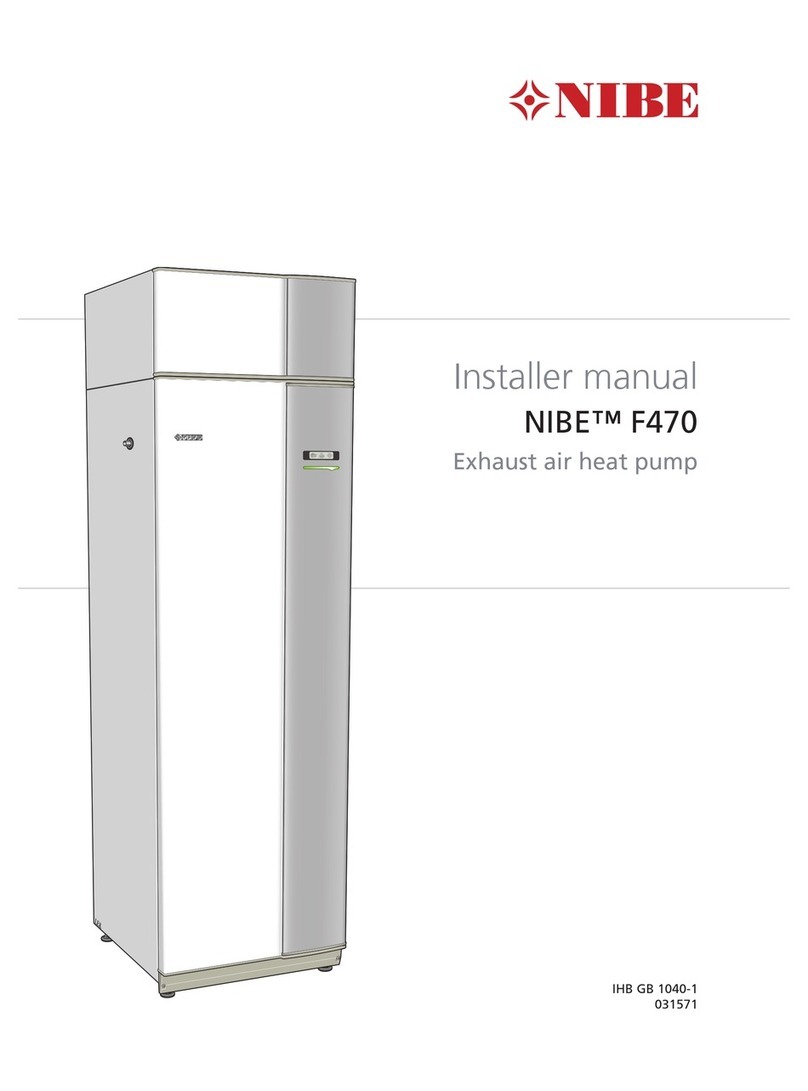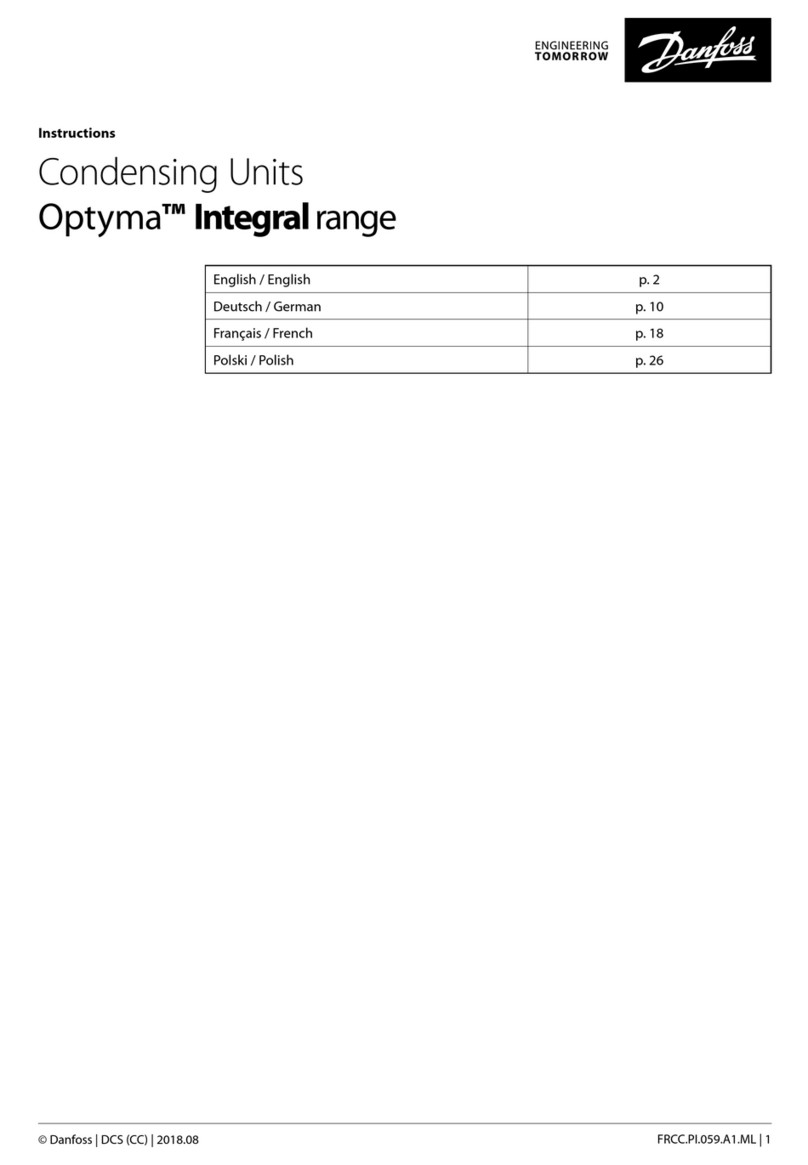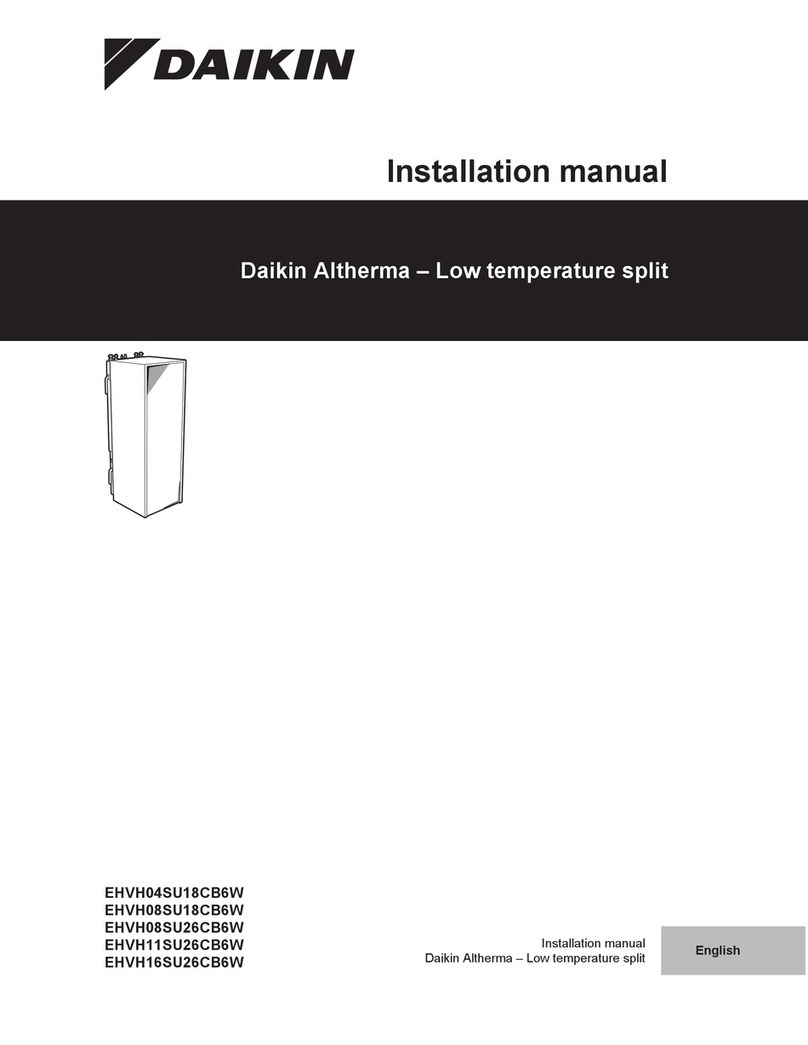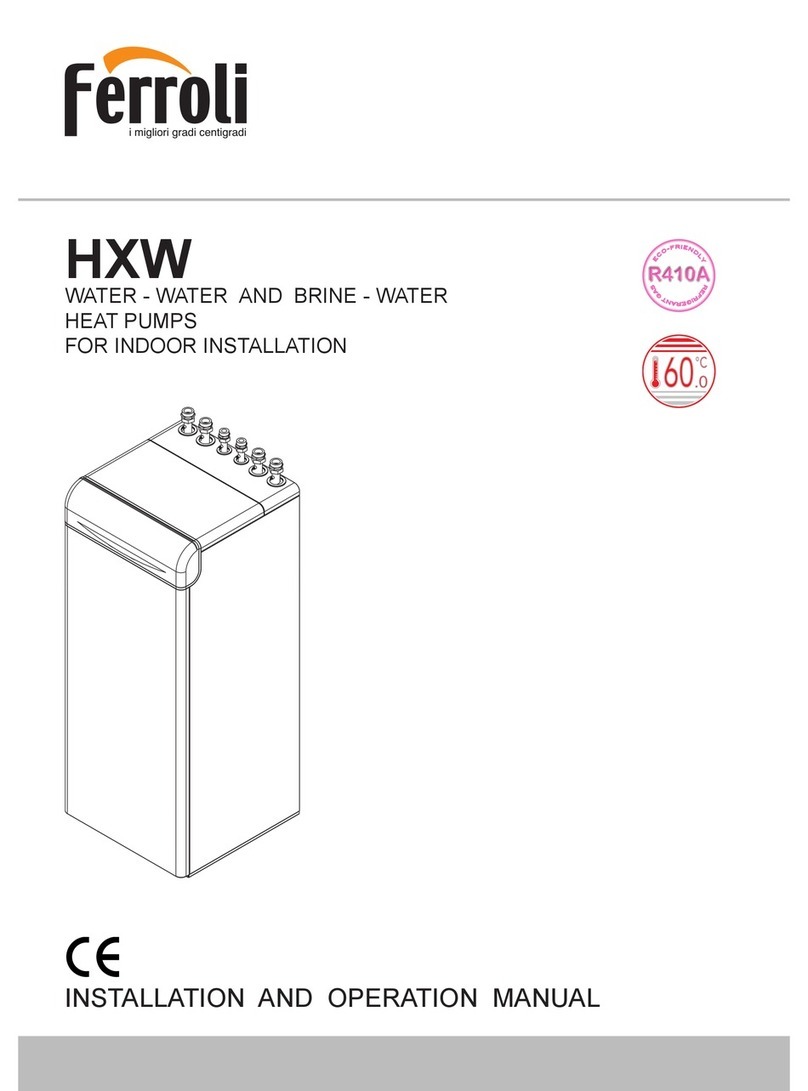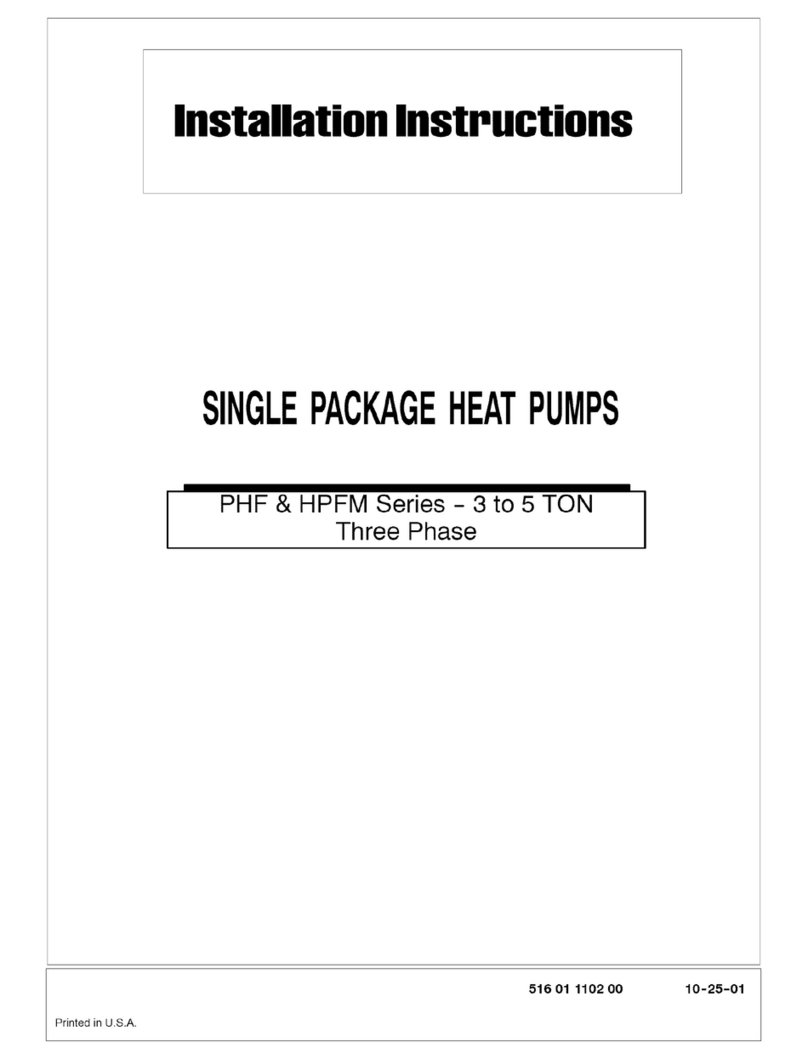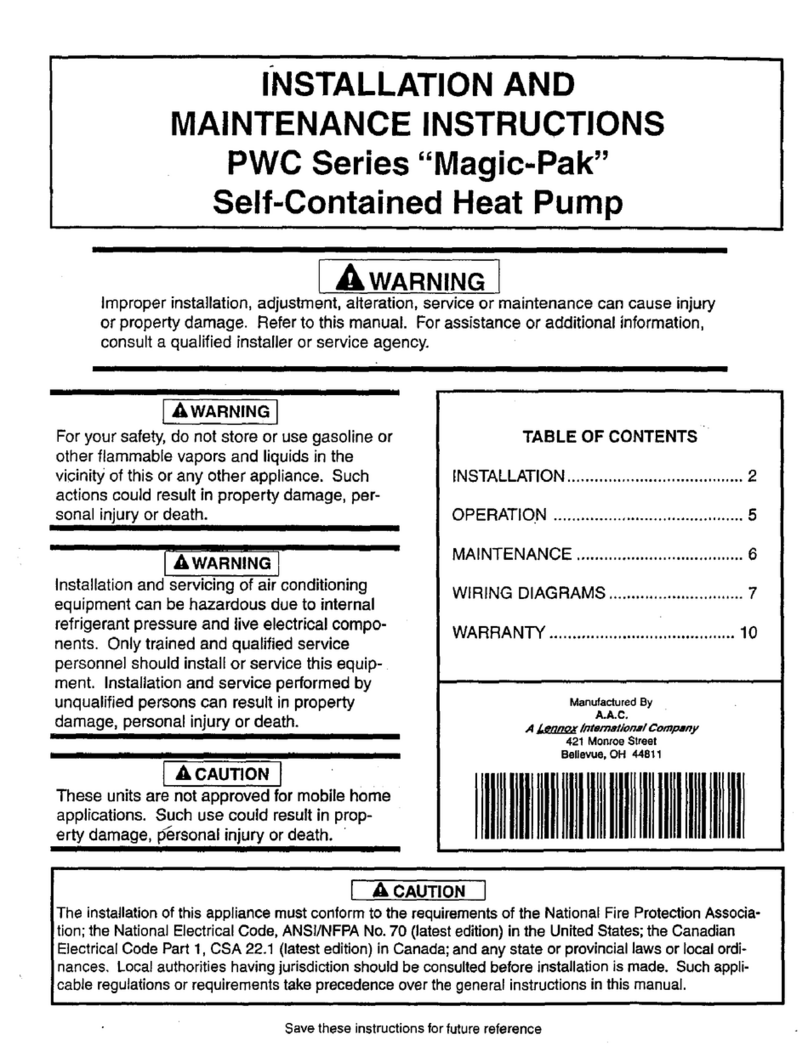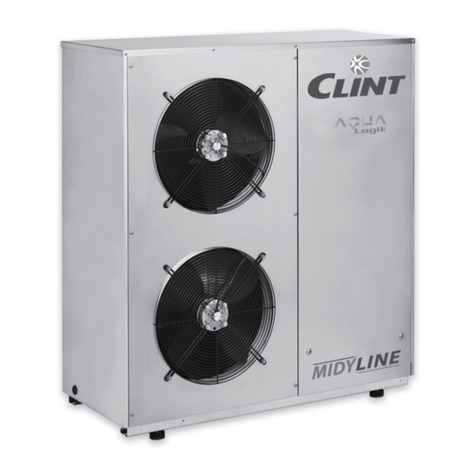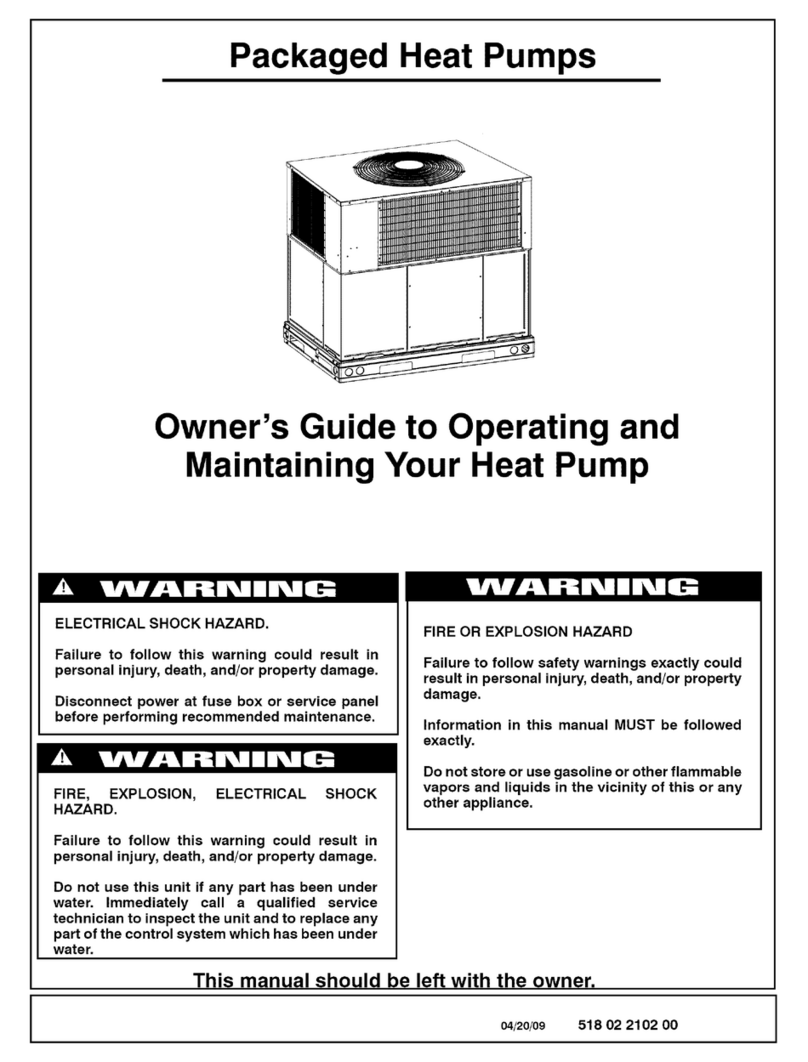ClimateWorx 11 Series User manual

Series 11, Ceiling Units
Installation Manual
.cnIlanoitanretnIxroWetamilC
S11-IM2019 14 Chelsea Lane, Brampton, Ontario, Canada L6T 3Y4

Series 11 Installation Guide
S11-IM2019
2
Table of Contents
Table of Contents ................................................................................................................. 2
Site Preparation .................................................................................................................... 3
Location Consideration ....................................................................................................... 3
Positioning of Indoor units.................................................................................................3
Hanging the Unit................................................................................................................4
Positioning of Condensers or Condensing Units ...............................................................5
Positioning of Remote Controller Unit ..............................................................................6
Positioning of Remote Temperature/ Humidity Sensor......................................................6
Electrical Installation ........................................................................................................... 7
Power Feeding ...................................................................................................................7
Interconnecting Wiring ......................................................................................................7
Piping Connections ............................................................................................................... 8
Recommended Pipe Size for Remote Condensing Units.....................................................9
Recommended Pipe Size for Remote Condensers ............................................................10
Consult Factory for additional distances ..........................................................................10
Evacuation........................................................................................................................10
Fan Speed Control System ................................................................................................ 11
Head Pressure Control System ......................................................................................... 12
Operating the Thermostat ................................................................................................. 14
Dimensional Details ............................................................................................................ 17
Appendix A: Dimensional Drawings ................................................................................ 18
Appendix B: Electrical Schematic Drawings ................................................................... 33
Appendix C: Piping Schematic Drawings ........................................................................ 48

Series 11 Installation Guide
S11-IM2019 3
Site Preparation
In order to maximize operating efficiency and performance, the following areas should be observed at the
site-planning stage:
- The room should be surrounded with a vapor seal to eliminate moisture migration through the
building structure. Windows should be sealed and at least double-glazed to prevent sweating. All
door jams should fit tightly and should not have any grilles in them. Polyethylene film type ceiling,
vinyl wallpaper or plastic based paint on the walls and slabs are recommended to minimize
absorption and transmission of moisture into the room.
- Owing to a generally small population, a typical room should have fresh air kept at only about 5% of
the re-circulated air. This provides enough ventilation for personnel and pressurizes the room to
prevent dust from entering through leaks. The incoming fresh air must be filtered very closely, and
preferably pretreated. Otherwise heating, cooling, humidifying and dehumidifying loads of the
incoming fresh air should be taken into account in determining total loading requirements.
Location Consideration
Positioning of Indoor units
The Series 11 unit is designed for ceiling mounting in or above a suspended T-bar ceiling grid. Care
should be taken to ensure that the supply and return air-paths are not blocked by equipment; preferably
the unit should be located over a clear floor space for ease of service. Additionally the units contain water
and as a result should not be mounted above equipment that could be damaged by water. It is
recommended that a field supplied drain pan complete with drain be installed beneath ducted units and all
water and glycol condensing units / condensers.
The unit should be mounted in such a way that the side panels can be easily accessed through the
surrounding ceiling tiles for service.
For spot cooling units (fully packaged) care should be taken in orienting the air grille supplied. The filter
grille (return air to the unit) should be located under the evaporator and the three way grill located under
the supply air section. The louvers on the supply air grill should be directed away from the return air to
avoid short circuiting of air.
The unit should be mounted above the flange of the T-Bar ceiling grid using the foam insulation provided
with the grille to seal to the bottom of the unit. Adjusting Fan Speed with M52 on grille supply/ return
models. For thermostat or ducted applications air balancing is required to adjust for correct fan speed.
Model 11XX15 11XX20 11XX25 11XX30
Standard Air Volume CFM 750 950 1100 1400
Cooling Max % 43 51 57 71
Idle Air Volume CFM 490 620 715 910
Cooling Min % 29 36 41 49

Series 11 Installation Guide
S11-IM2019
4
Hanging the Unit
Before hanging the unit, ensure the mounting surface is capable of supporting the unit’s weight. Refer to
Table 1 for unit weights.
Model 1 Ton
(Weight lbs)
1.5 Ton
(Weight lbs)
2 Ton
(Weight lbs)
2.5 Ton
(Weight lbs)
3 Ton
(Weight lbs)
4 Ton
(Weight lbs)
5 Ton
(Weight lbs)
Ai
r
-cooled self contained 235 240 245 250 N/A N/A N/A
DX Ai
r
-cooled 175 180 185 190 230 475 490
Air Handlin
g
Uni
t
110 110 110 110 140 415 430
Wate
r
-cooled self-contained 215 220 225 230 275 545 560
Gl
y
col-cooled self-contained 215 220 225 230 275 545 560
Chilled wate
r
110 110 110 110 140 415 430
Dual Cooled CW+CW N/A N/A N/A N/A N/A 515 530
Dual Cooled CW + DX Ai
r
N/A N/A N/A N/A N/A 575 590
Dual Cooled CW + DX Wate
r
N/A N/A N/A N/A N/A 645 660
Dual Cooled CW + DX Gl
y
col N/A N/A N/A N/A N/A 645 660
Free Coolin
g
N/A N/A N/A N/A N/A 665 680
Table 1: Unit Weights
Attach the corner brackets to the corner posts of the
unit. Remove all the access panels and lift the unit into
the selected position. Using threaded hanging rod (3/8”
diameter) secure the unit in place using nuts and
washers (all field supplied).
For units supplied with vibration isolating spring
mounts place spring under corner bracket and attach
locking hardware. After hanging the unit, adjust spring
tensions to level the unit, shown in Figure 1.
Figure 1

Series 11 Installation Guide
S11-IM2019 5
Positioning of Condensers or Condensing Units
Condensing units should be located as close to the indoor unit as possible. From a security and
environment standpoint, outdoor air-cooled condensing units should be installed away from public access
and occupied spaces where low ambient sound level is required. Indoor air-cooled condensers or
condensing units should be located in areas where normal unit operating sound will not disturb the
working environment. Water and glycol condensing units should not be located above sensitive
equipment that could be damaged by water.
In order to avoid air short circuiting and inter unit re-circulation, air-cooled condensing units/condensers
should be located at least 1m (3 ft.) away from any walls, obstructions or adjacent units. To ensure
maintenance-free operation, air cooled condensing units/condensers should be located away from the
areas that are continuously exposed to loose dirt and foreign materials that may clog the coil.
Indoor condensing units / condenser should be hung following the procedure outlined earlier. Outdoor
units should be firmly secured on steel supports or concrete plinths.
For packaged units the condenser fan box is supplied loose. To attach, position evaporator section, then
bring the fan box in from below and place the lip (Figure 2) inside the top cover lip (on evaporator unit).
Push the condenser fan box from the bottom until it fits snugly. Use hardware provided to attach the fan
box to the evaporator section.
Figure 2

Series 11 Installation Guide
S11-IM2019
6
Positioning of Remote Controller Unit
The remote mounted controller should be located in an easily accessible area within reach of operating
personnel. For proper operation the thermostat should be located on an inside wall. In addition its
position must be at least 18” (46 cm) from any outside wall, and approximately 5’ (1.5m) above the floor
in an area with freely circulating air of average room temperature. In addition the following locations
should be avoided:
1. Behind doors or in corners where freely circulating air is unavailable.
2. Where direct sunlight or radiant heat might affect readings.
3. On outside walls
4. Adjacent to or in line with conditioned air discharge grilles, stairwells or outside doors.
5. Where its operation may be affected by steam or water pipes or warm air stacks in an adjacent
partition, or by an unheated /uncooled area behind the thermostat.
6. Where its operation will be affected by the supply air of an adjacent unit.
Consideration should be given to interconnecting wiring between indoor unit and controller. The
maximum distance between indoor unit and controller should be 50’.
Positioning of Remote Temperature/ Humidity Sensor
The remote mounted Temperature/ Humidity sensor should be located in an easily accessible area within
reach of maintenance personnel. Its position must be at least 18” (46 cm) from any outside wall, and
approximately 5’ (1.5m) above the floor in an area with freely circulating air of average room
temperature. In addition the following locations should be avoided:
1. Behind doors or in corners where freely circulating air is unavailable.
2. Where direct sunlight or radiant heat might affect readings.
3. On outside walls
4. Adjacent to or in line with conditioned air discharge grilles, stairwells or outside doors.
5. Where its operation may be affected by steam or water pipes or warm air stacks in an adjacent
partition, or by an unheated /uncooled area behind the sensor.
6. Where its operation will be affected by the supply air of an adjacent unit.
Consideration should be given to interconnecting wiring between the M52 Remote Supervisory panel and
the Remote T/H sensor. The Remote T/H sensor is provided with 25’ of cable from the connection point
within the Remote Supervisory panel.

Series 11 Installation Guide
S11-IM2019 7
Electrical Installation
Power Feeding
All models are fitted with a 3-terminal connection block. Single-phase power should be connected to the
line side of the connection block. A ground lug is provided near the main power connection block for
ground connection. (3 phase is an option on some units). Entering service cable should be fed through the
hole on the side of the unit marked “Power”.The power cables should be sized in accordance with local
and national codes. Refer to the unit nameplate for circuit ampacity.
Interconnecting Wiring
Thermostat Control
Field supplied thermostat grade 5 conductor cable to be used between evaporating section and the wall
mount thermostat.
M52 Controller
Pre-made control cable sets are supplied with each unit fitted with the M52 Controller, for connecting the
remote mounted controller and remote mounted temperature/ humidity sensor to the indoor unit. Standard
cable lengths are 25 feet between the evaporator section and wall mount controller, and 25 feet between
the evaporator section and the temperature/ humidity sensor. Each cable will be clearly marked and care
should be taken to ensure cables are connected correctly. Internal wiring for all Series 11 is completed
and tested prior to delivery. Numbered terminal blocks for field installed control wiring are provided next
to the main power isolator at the lower right corner of the power panel.
The numbered terminal blocks will accept control wiring up to #12 AWG (4mm²) gauge. The terminal
assignments are listed as follows:
Terminal Function Requirement
11-12 Standby enable Normally open output
13-14 Common alarm (General) Normally open output
21-22 Common alarm (Critical) Normally open output
15-16 Remote on / off Normally open dry contact input
17-18 Standby start Normally open dry contact input
19-20 Fire alarm Normally closed dry contact input
23 thru 28 Condenser/Pump interlock Normally open dry contact output
31-32 Compressor disable (optional) Normally open dry contact input
35-36 Remote on/off Interrupt (optional) Normally open dry contact input
37-38 Unit Status (optional) Normally open dry contact output
39- 42 Custom Fault1/2 (optional) Normally closed dry contact input
43- 44 Liquid High Limit (optional) Normally closed dry contact input
49- 50 Hum/ Reheat disable (optional) Normally open dry contact input
57- 58 Damper Motor Interlock (optional)Normally open dry contact output
59- 60 Damper End Switch (optional) Normally open dry contact input

Series 11 Installation Guide
S11-IM2019
8
Packaged unit condenser fans
The condenser fan is supplied with a 3’ length conduit/cable assembly. Attach conduit connector through
the 1” hole located at the bulkhead at the top left hand corner of the electrical panel (Figure 3). Connect
the two cables as per wiring diagram to the loom marked condenser fan.
Figure 3
Piping Connections
Condensate Drain
For proper drainage a P-trap MUST be installed. Total height for the trap should be measured from the
bottom of the drain pan (3” above unit bottom), to the bottom of the “U” in the trap. Minimum recommended
height is 3.5” to ensure proper drainage.
Refrigerant Piping
For self contained (packaged) systems no refrigerant connections are required.
Good practice should always be followed when connecting refrigerant piping in direct expansion systems.
As many of the operational problems encountered in a refrigeration system can be traced back to
improper design and installation of refrigerant piping, it is essential that the following guidelines be
observed:
- Use clean and dehydrated refrigeration quality tubing with both ends sealed.
- Cut and form tubes carefully to avoid getting dirt or metal particles into the refrigeration lines. Never
use a hacksaw to cut the tubing.

Series 11 Installation Guide
S11-IM2019 9
- Once the system is open, complete the work as quickly as possible to minimize ingress of moisture
and dirt into the system. Always put caps on ends of tubes and parts not being worked on.
- To prevent scaling and oxidation inside the tubing, pass an inert gas such as nitrogen through the line
while carrying out brazing, silver soldering or any other welding processes.
- It is recommended that quality refrigeration solder (95% tin, 5% silver) is used for its excellent
capillary action.
- Use minimum amount of solder flux to prevent internal contamination of the piping. Use flux with
care as it is usually acidic in nature.
- Install a trap at the bottom of every on the vertical riser of a hot gas or suction line and one for every
6m (20ft.) in elevation to collect refrigerant and lubrication oil during off cycle. A discharge line trap
is an important function both during the compressor on and during the compressor off cycle. During
the on cycle, the trap collects oil droplets and carries them efficiently up the elevated discharge line.
During the off cycle, the traps captures and retains oil residing on the pipe walls that would
otherwise drain back to the compressor head, causing damage on startup.
- Install inverted trap whenever a condenser is located above the compressor. An inverted trap or check
valve should be installed at the condenser inlet and outlet to prevent liquid refrigerant from flowing
backwards into the compressor during off cycles.
- Insulate the suction line and insulate liquid lines that may be subjected to high heat gains. Insulate
low level discharge lines to avoid burning due to accidental contact.
- Design and arrange refrigerant piping for the remote condenser in such a way so that adequate
velocity of refrigerant can be maintained to prevent oil trapping. Under sizing discharge lines will
reduce compressor capacity and increase compressor load. Over sizing discharge lines increases the
initial cost of the project and can reduce the refrigerant gas velocity to a level where oil is not
returned to the compressor.Recommended pipe sizes are tabulated as follows:
Recommended Pipe Size for Remote Condensing Units
Model 1 Ton 1.5 Ton 2 Ton 2.5 Ton 3 Ton 4 Ton 5 Ton
Liquid Line
50 ft. equivalent pipe length 3/8” 3/8” 3/8” 3/8” ½” ½” ½”
Suction Line
50 ft. equivalent pipe length 5/8” 5/8” 3/4” 3/4” 7/8” 7/8” 1 1/8”

Series 11 Installation Guide
S11-IM2019
10
Recommended Pipe Size for Remote Condensers
Model 1 Ton 1.5 Ton 2 Ton 2.5 Ton 3 Ton 4 Ton 5 Ton
Hot Gas Line
50 ft. equivalent pipe length 1/2” 1/2” 5/8” 5/8” 5/8” 3/4” 3/4”
100 ft. equivalent pipe length 1/2” 5/8” 5/8” 3/4” 3/4” 3/4” 7/8”
150 ft. equivalent pipe length 5/8” 5/8” 3/4” 3/4” 3/4” 7/8” 7/8”
175 ft. equivalent pipe length N/A N/A 3/4” 3/4” 7/8” 7/8” 1 1/8”
200 ft. equivalent pipe length N/A N/A N/A 3/4” 7/8” 7/8” 1 1/8”
Liquid Line
50 ft. equivalent pipe length 3/8” 3/8” 3/8” 3/8” 1/2” 1/2” 1/2”
100 ft. equivalent pipe length 3/8” 3/8” 3/8” 1/2” 1/2” 1/2” 1/2”
150 ft. equivalent pipe length 3/8” 3/8” 1/2” 1/2” 1/2” 5/8” 5/8”
175 ft. equivalent pipe length N/A N/A 1/2” 1/2” 1/2” 5/8” 5/8”
200 ft. equivalent pipe length N/A N/A N/A 1/2” 1/2” 5/8” 5/8”
Consult Factory for additional distances
Evacuation
The procedure for leakage testing and evacuation of the system is as follows:
1. Disconnect all line voltage fuses except the fuses for control transformers.
2. Connect a gauge manifold to the compressor suction and discharge access valve.
3. Close the compressor discharge and suction ports and open all service valves.
4. Charge the system with dry nitrogen to approximately 150 psig.
5. Leave pressure in system for at least 12 hours. If pressure holds, continue with next step. If the
pressure drops, detect and seal leak before continuing.
6. Release all pressure. Connect a vacuum pump to the compressor suction and discharge valves with
refrigerant or high vacuum hoses. Provide an isolating valve and a pressure gauge for pressure
checking.
7. Evacuate the system to an absolute pressure not exceeding 1500 microns. Break the vacuum to 2psig
with dry nitrogen. Repeat the evacuation process and then re-break the vacuum with dry nitrogen.
8. Open the compressor discharge and suction ports. Evacuate to an absolute pressure not exceeding
500 microns. Let the vacuum pump run without interruption for minimum two hours.

Series 11 Installation Guide
S11-IM2019 11
9. Stop the vacuum pump. Break the vacuum and charge the system with vapor R22/R407c (see spec
label for unit refrigerant) through the discharge side of the compressor. It is a good practice to weigh
the charge that is put into the system.
10. Allow the pressure to equalize.
Fan Speed Control System
The fan speed control system maintains not only a constant condensing pressure over a wide range of
climatic conditions but also high sensible cooling for the evaporator so that re-humidification is rarely
required throughout the year.
A pressure-sensitive fan speed controller is employed in the fan speed control system. It regulates the
condenser head pressure at low ambient temperatures by varying the airflow volume through the
condenser.
Upon engaging the interlock contact in the indoor unit, the fan speed controller will directly sense the
changes in the refrigerant head pressure and vary the output voltage from 15% to 97% of the applied
voltage.
Charging
Calculate the total charge required using this formula:
Indoor Unit Charge + Liquid Line Charge + Condenser Charge
+ Hot gas Line Charge = Total Charge
Proper performance of the system depends largely on proper charging. Adhere to the following guidelines
for charging:
1. Open the main isolator and insert the fuses for the fans, control transformers and the compressor.
2. Close the main isolator and allow the compressor crankcase heater to operate for at least one hour.
3. Connect the gauge manifold to both discharge and suction rotalock valves, with a common
connection to the refrigerant cylinder. Purge the lines by opening the refrigerant cylinder vapor
valve.
4. Connect the refrigerant cylinder to recovery unit and charge system with 90% of calculated amount.
5. Start the unit using the test mode to energize the main fan and compressor. Please make sure
outdoor condenser (if any) is powered.
6. Add additional refrigerant to the system until the sight glass is clear of bubbles and subcooling is
measured between 10-15 oF.
7. Run system to maintain a hot gas (discharge) pressure based on refrigerant used (R407C @240psi
and R22 a @225psi) then re-check subcooling, Add refrigerant if subcooling has dropped below 10
oF.

Series 11 Installation Guide
S11-IM2019
12
8. The system is now correctly charged for operating under fan speed control. It is a good practice to
weigh the amount of additional refrigerant that was added and keep a record of the total charge in
the system.
Note: Packaged Air cooled systems come completely factory charged (except when a factory split is ordered). Fan speed
control is provided by a discharge pressure transducer to maintain a constant head pressure. This is factory set to perform at
peak performance and does not need to be set or adjusted on site.
Head Pressure Control System
For condensers possibly subjected to extremely low ambient temperature, it is recommended that a head
pressure control system be installed. This avoids starving the evaporator coil, with the consequence of oil
clogging; short cycling on low pressure control, reduction of the system capacity and erratic expansion
valve operation.
A drop in the condensing pressure often occurs in air-cooled systems as a result of low ambient
conditions encountered during fall-winter-spring operation. Head pressure control renders part of the
condenser surface inactive. The reduction of active condensing surface results in a rise in condensing
pressure and hence provides a sufficient liquid line pressure for normal system operation. The head
pressure control system allows operation at extremely low ambient temperature down to -40°F.
ClimateWorx uses a two-valve head pressure control with receiver, for factory ordered condensers. The
ORI is located in the liquid drain line between the condenser and the receiver, and the ORD is located in a
hot gas line bypassing the condenser.
During periods of low ambient temperature, the condensing pressure falls until it approaches the setting of
the ORI valve. The ORI then throttles, restricting the flow of liquid from the condenser. This causes
refrigerant to back up in the condenser thus reducing the active condenser surface. This raises the
condensing pressure. Since it is really the receiver pressure that needs to be maintained, the bypass line
with the ORD is required.
The ORD opens after the ORI has offered enough restriction to cause the differential between condensing
pressure and receiver pressure to exceed 20psi. The hot gas flowing through the ORD serves to heat up
the cold liquid being passed by the ORI. Thus the liquid reaches the receiver warm and with sufficient
pressure to assure proper expansion valve operation. As long as sufficient refrigerant charge is in the
system, the two valves modulate the flow automatically to maintain proper receiver pressure regardless of
outside ambient.
Charging
Calculate the total charge required using this formula:
Indoor Unit Charge + Liquid Line Charge + Condenser Charge
+ Hot gas Line Charge + 20% of Receiver volume = Total Charge
When head pressure control is utilized, there must be enough refrigerant to flood the condenser at the
lowest expected ambient and still have enough charge in the system for proper operation. After

Series 11 Installation Guide
S11-IM2019 13
completing the evacuation procedures as in the fan speed control system, follow the following guidelines
for charging:
1. Open the main isolator and insert the fuses for the fans, control transformers and the compressor.
2. Close the main power and allow the compressor crankcase heater to operate for at least one hour.
3. Connect the gauge manifold to both discharge and suction rotalock valves, with a common
connection to the refrigerant cylinder. Purge the lines by opening the refrigerant cylinder vapor
valve.
4. Connect the refrigerant cylinder to recovery unit and charge system with 90% of calculated amount.
5. Start the unit using the test mode to energize the main fan and compressor. Please make sure
outdoor condenser (if any) is powered.
6. Add additional refrigerant to the system until the sight glass is clear of bubbles and subcooling is
measured between 10-15 oF.
7. Run system to maintain a hot gas (discharge) pressure based on refrigerant used (R407C @240psi
and R22 a @225psi) by adjusting ORI valve(s) then re-check subcooling, Add refrigerant if
subcooling has dropped below 10 oF.
8. The system is now correctly charged for operating under head pressure control at the ambient
temperature charging is being carried out. It is a good practice to weigh the amount of additional
refrigerant that was added and keep a record of the total charge in the system.
9. If the system is designed to operate at ambient below the ambient that exists during charging,
additional charge will have to be added now.
Method to Determine Additional Refrigerant Charge to Operate to an Expected Minimum Ambient Temperature
Example for KS11-078-1 Ambient Temp at Time of Charging = 60°F
to Operate to -30°F
Step 1. At the ambient temperature at the time of charging the system (e.g 60°F)
Read from the table – % of Condenser to be Flooded (e.g - 10 %)
Step 2. At the expected minimum ambient Temperature (e.g - - 30 °F )
Read from the table - % of the Condenser to be Flooded (e.g - 77 %)
Step 3. Calculate the difference of the above two values
( 77 % - 10 % = 67 % )
Step 4. From the “ Air Cooled Condenser Guide” read Winter Flooded ( -40°F )
Refrigerant Charge ( 6.4 lbs )
Step 5. Multiply the value found in Step 4 by the difference in %’s calculated
in Step 3.
Additional Required Charge = 6.4 lb * ( 67 % ) = 4.30 lb / Condenser
( If Two (2) Circuit Condenser 2.15 lb / Ref Circuit

Series 11 Installation Guide
S11-IM2019
14
Operating the Thermostat
Setting the Current Day and Time
1. Press the CLOCK Button. The display will flash a day of the week.
2. Press the up or down arrow buttons until the current day shows.
3. Press the CLOCK button again. The display will flash the hour. (Note the AM/ PM indicator.)
4. Press the up or down arrow buttons until the current hour shows.
5. Press the CLOCK button again. The display will flash the minutes.
6. Press the up or down arrow buttons until the current minutes show.
7. Press the CLOCK button and the current day and time are now set.
* Note: If a button is not pushed in 15 seconds, the thermostat will automatically return to normal
operation.
Setting your Program Temperatures
With your specific program determined, you are ready to begin programming. You will now enter the
individual program period temperatures for the heating program.
1. Press the MODE button until HEAT is displayed.
2. Press the SET TEMP button. The first program period (Morning) will be displayed.
3. Press the up or down arrow buttons to adjust that program period’s temperature for heating.
4. Repeat Steps 2 and 3 for the Day, Evening and Night program periods. Remember, if your
thermostat was set for two program periods, you will only have to repeat Steps 2 and 3 for the Night
program period.
5. Press the MODE button until COOL is displayed. You now will enter the individual program period
temperatures for the cooling program.
6. Repeat Steps 2, 3 and 4 for the cooling temperatures.
7. Press the MODE button until your desired mode of operation appears: HEAT- AUTO- OFF- COOL.
8. Press the RESUME button to return to normal operation.
Note: If a button is not pushed in 15 seconds, the thermostat will automatically return to normal
operation. You may go back into the programming portion simply by repeatedly pressing the SET TEMP
button until you get back to where you left off.

Series 11 Installation Guide
S11-IM2019 15
Setting your Program Times
Referring to your Schedule Planner, you now will enter the times for the program periods.
1. Press the PROGRAM button. The display will flash a day of the week.
2. Press the up or down arrow buttons to select the day you wish to program. (We suggest starting with
Monday.)
3. Press the PROGRAM button. The display will flash the hour of the first period (Morning). (Note the
AM/ PM indicator.)
4. Press the up or down arrow buttons to adjust the desired hour for the first program period.
5. Press the PROGRAM button again. The display will flash the minutes.
6. Press the up or down arrow buttons to adjust the desired minutes for the first period. (Note the
minutes are in increments of 10.)
7. Repeat Steps 3- 6 for the Day, Evening and Night periods. Remember that if your thermostat was set
for two program periods, you will only have to repeat Steps 3- 6 for the Night period.
8. After entering the Night period, press the PROGRAM button. COPY will be displayed. The copy
function will allow program times to be copied to sequential days. If you do not wish to copy the
program times to another day (or block of days), proceed to Step 11.
9. Press the up or down arrow buttons to select the next individual day, or block of days, to copy the
program times to.
10. Press the PROGRAM button to copy the program times to the selected days of the week.
11. Repeat Steps 1- 10 for any remaining unprogrammed days of the week.
12. When finished, you can verify that all program periods are programmed correctly by repeatedly
pressing the PROGRAM button. When COPY appears, press the PROGRAM button to skip to the
next day.
* Note: If a button is not pushed in 15 seconds, the thermostat will automatically return to normal
operation. You may go back into the programming portion simply by repeatedly pressing the
PROGRAM button until you get back to where you left off.
Temperature Override
Temporary Override (3 hours)
You may change the temperature setting temporarily at any time without affecting the program.
Press the up or down arrow buttons. The current event temperature and mode of operation will be
displayed. Press the up or down arrow buttons again to adjust the temperature. This temperature will be
maintained for three hours. To cancel, simply press the RESUME button.

Series 11 Installation Guide
S11-IM2019
16
Temporary Override with Keyboard Locked (1 hour) (300- 225, 300- 227, 300- 229)
You may change the temperature setting temporarily at any time without affecting the program, even
though the keypad is locked.
• Press the up or down buttons. The display will show the temperature for the first event. Press the up or
down buttons again to adjust the temperature +/- 3 degrees. This temperature will be maintained for one
hour.
Continuous Override (Hold)
You also may maintain a constant temperature setting at any time without affecting the program.
1. Press and release the MODE button until the desired mode is displayed (HEAT – AUTO – OFF –
COOL)
2. Press and release the HOLD button. HOLD will be displayed.
3. Press the up or down buttons to adjust the temperature. This temperature will be maintained
indefinitely. To cancel, simply press the RESUME button.
Note: If the auto mode is used, press the MODE button, then press the up or down buttons to select a
heating setpoint. Press the MODE button, and then press the up or down buttons to select a cooling
setpoint.
Changing Fahrenheit (°F) to Celsius (°C)
This thermostat is preset to display the temperature in Fahrenheit. You may change the display to Celsius.
To change from one to the other, simultaneously press the up and down buttons. The display will change
automatically.
Changing 12 Hour Time to 24 Hour Time
This thermostat is preset to display the standard 12 hour time format. You may change the display to the
24 hour time format. To change from one to the other, press and release the CLOCK button, then press
the MODE button. The display will change automatically.
Power Failures
This Robertshaw thermostat will maintain the program settings during any type of power failure. If power
fails, AC will be displayed for 30 minutes. After 30 minutes, the display will go blank. If power is
restored within the first 30 minutes, the thermostat will resume normal operation. If power is restored
after 30 minutes, 12: 00 AM will flash, and the thermostat will control to the night event set point until
the clock is reset. Once the clock is reset, the thermostat will resume normal operation.

Series 11 Installation Guide
S11-IM2019 17
Dimensional Details
The following tables summarize the dimensional detail drawing number for Series 11 units with standard
options. For units with a special option or configuration, please consult factory for details.
Model -10 -15 -20 -25
Self-contained air-cooled unit S11DD101 S11DD101 S11DD101 S11DD101
Ducted self-contained air-cooled unit S11DD152 S11DD152 S11DD152 S11DD152
Self-contained water/glycol unit S11DD111 S11DD111 S11DD111 S11DD111
Chilled water unit S11DD121 S11DD121 S11DD121 S11DD121
Indoor evap. section w/compressor S11DD131 S11DD131 S11DD131 S11DD131
Indoor evap. section S11DD141 S11DD141 S11DD141 S11DD141
Ducted evaporator connections S11DD151 S11DD151 S11DD151 S11DD151
Condenser/Condensing Unit
Outdoor condenser/condensing unit S11DD202 S11DD202 S11DD202 S11DD202
Indoor condenser/condensing unit S11DD161 S11DD161 S11DD161 S11DD161
Model -30 -40 -50
Self-contained unit S11D-BB-300 N/A N/A
Ducted self-contained unit S11-D-DD-300 S11DD501 S11DD501
Chilled water unit S11D-BB-300 N/A N/A
Ducted Chilled Water unit S11D-DD-300 S11DD501 S11DD501
Indoor evap. section S11D-BB-300 N/A N/A
Ducted Indoor evap. section S11D-DD-300 S11DD501 S11DD501
Condenser/ Condensing Unit
Outdoor condenser Horizontal* KS-F_H_R407C KS-F_H_R407C KS-F_H_R407C
Outdoor condenser Vertical* KS-F_V_R407C KS-F_V_R407C KS-F_V_R407C
Outdoor condenser w/ Receiver Kit* KS-H_V_R407C KS-H_V_R407C KS-H_V_R407C
MOD.KS11-065-01 MOD.KS11-065-01 MOD.KS11-078-01
Outdoor condensing unit S11DD202 N/A N/A
Indoor condenser WC/GC S11DD301 S11DD301 S11DD301
Indoor condensing unit WC/GC S11DD301 S11DD301 S11DD301
Indoor condenser unit Air Cooled S11DD301 S11DD301 S11DD301
Indoor condensing unit Air Cooled S11D-DD-300-004 S11D-DD-300-004S11D-DD-300-004

Series 11 Installation Guide
S11-IM2019
18
Appendix A: Dimensional Drawings
Drawing Title Drawing No. Page No.
SERIES 11 – Self-contained air-cooled unit-1 to 2.5 tons S11DD101 16
SERIES 11 – Ducted self-contained air-cooled unit-1 to 2.5 tons S11DD152 17
SERIES 11 – Self-contained water/glycol-cooled unit-1 to 2.5 tons S11DD111 18
SERIES 11 – Chilled water unit-1 to 2.5 tons S11DD121 19
SERIES 11 – Indoor evaporator section w/compressor-1 to 2.5 tons S11DD131 20
SERIES 11 – Indoor evaporator section-1 to 2.5 tons S11DD141 21
SERIES 11 – Ducted evaporator connections-1 to 2.5 tons S11DD151 22
SERIES 11 – Outdoor condenser/condensing unit-1 to 2.5 tons S11DD202 23
SERIES 11 – Indoor condenser/condensing unit-1 to 2.5 tons S11DD161 24
SERIES 11 – Grille Air Distribution-1 to 3 tons S11DD171 25
SERIES 11 – Self-contained/ chilled water/ evaporator-3 ton S11D-BB-300 26
SERIES 11 – Ducted chilled water/ evaporator-3 ton S11D-DD-300 26
SERIES 11 –Ducted chilled water / evaporator-4/ 5 ton S11DD501 27
SERIES 11 – Indoor condenser WC/GC-3 to 5 tons S11DD301 28
SERIES 11 – Indoor condensing unit WC/GC-3 to 5 tons S11DD301 28
SERIES 11 – Indoor condenser/condensing unit-3 to 5 tons S11D-DD-A-300-004 29

Series 11 Installation Guide
S11-IM2019 19

Series 11 Installation Guide
S11-IM2019
20
This manual suits for next models
4
Table of contents
Popular Heat Pump manuals by other brands
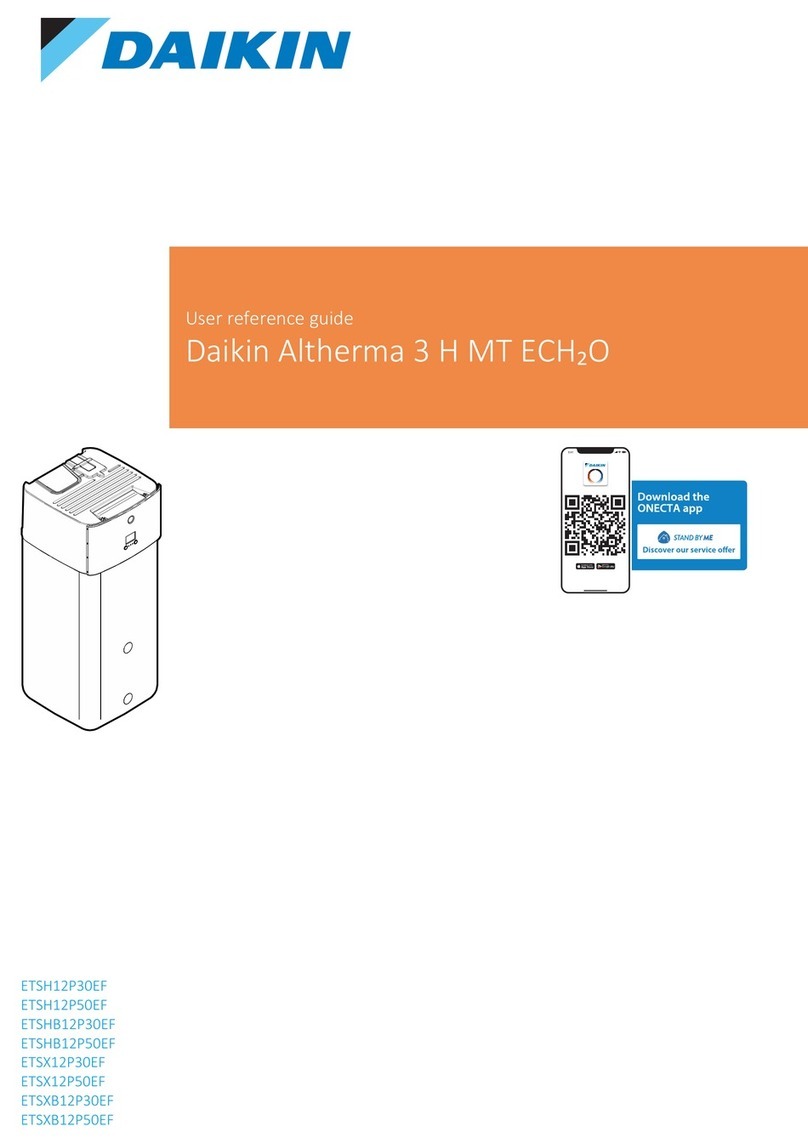
Daikin
Daikin ETSH12P50EF User reference guide
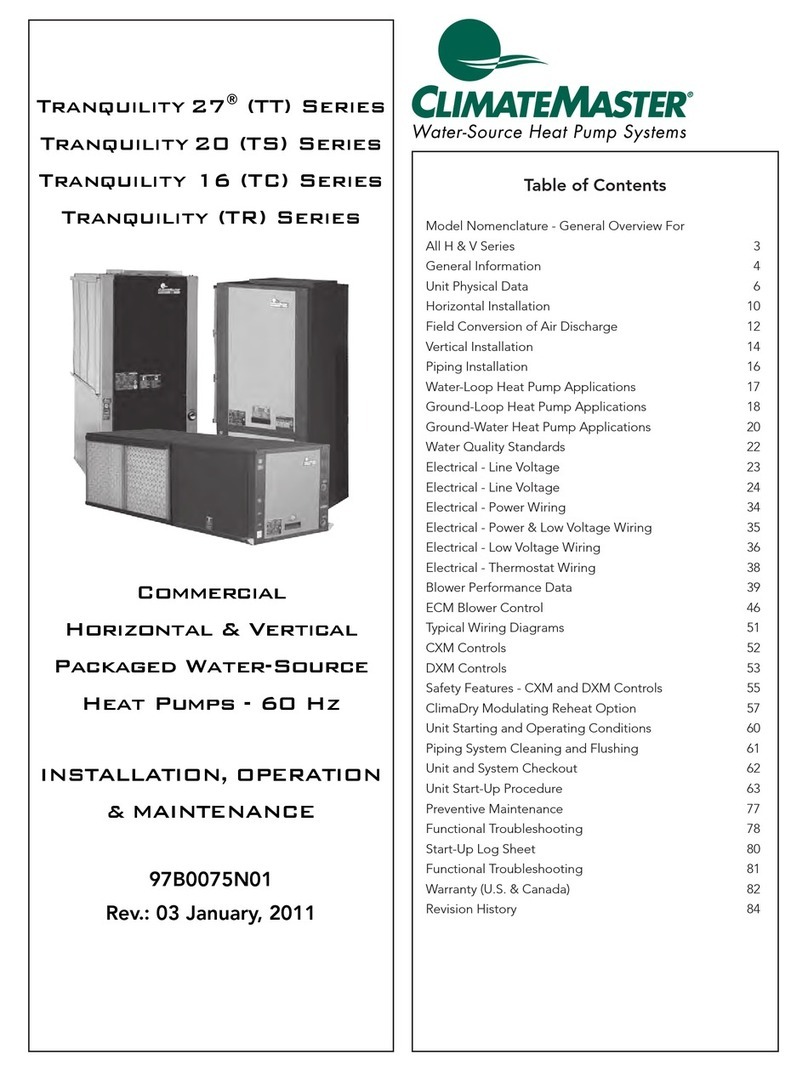
ClimateMaster
ClimateMaster Tranquility 27 TT Series Installation operation & maintenance
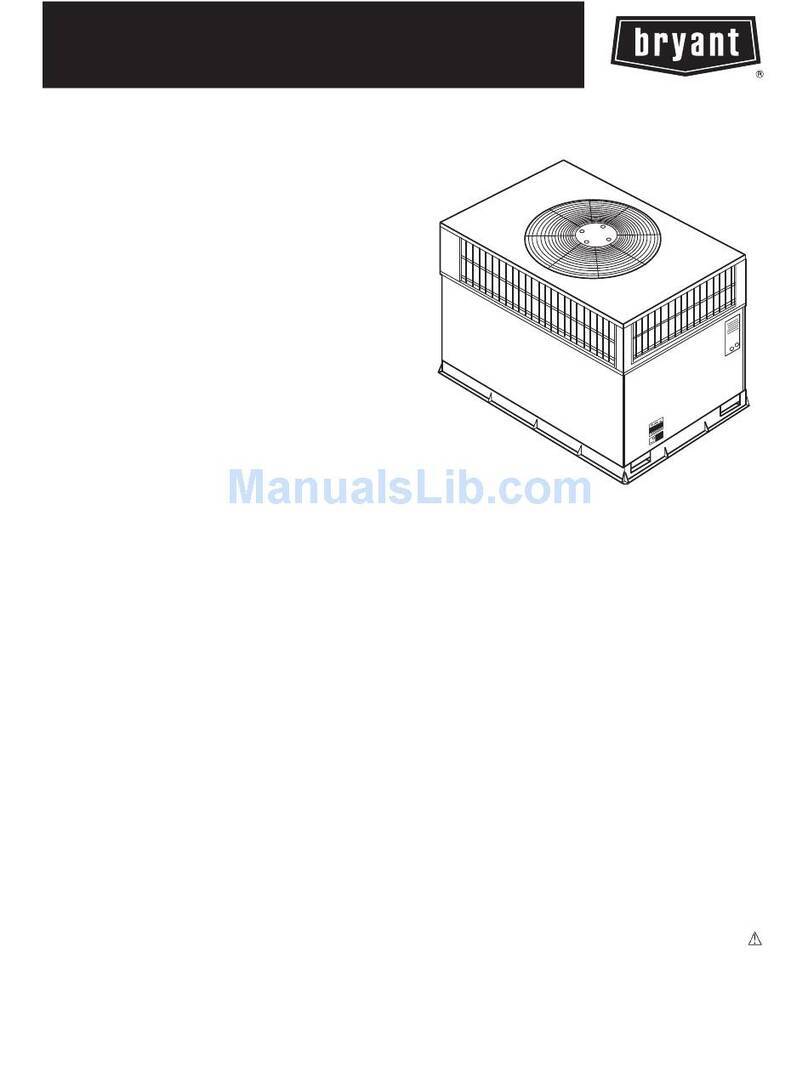
Bryant
Bryant 607C024 installation instructions
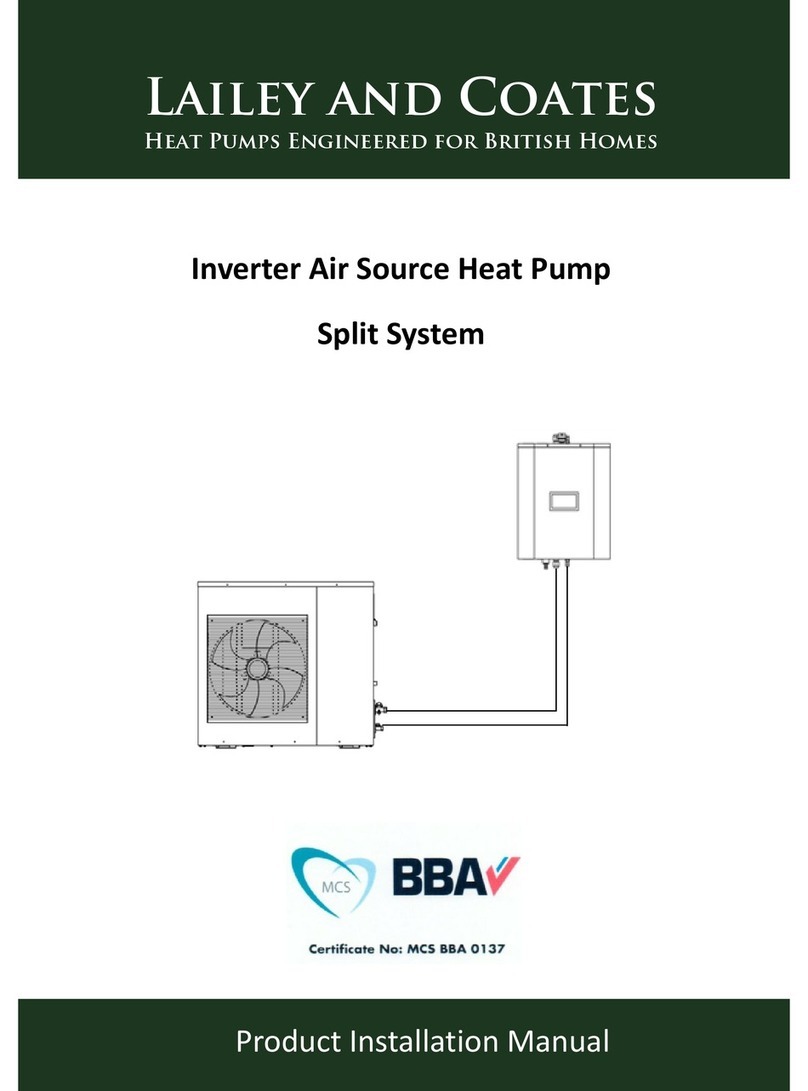
Lailey abd Coates
Lailey abd Coates LC-07 Product installation manual
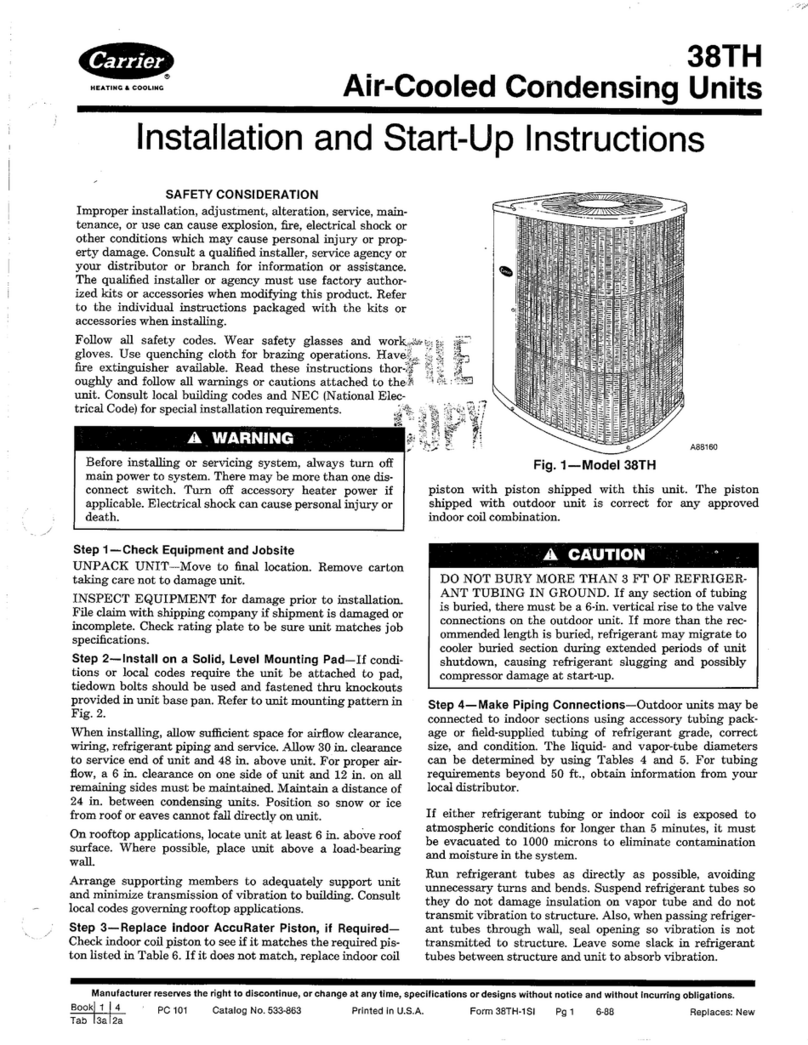
Carrier
Carrier 38TH Installation and start-up instructions
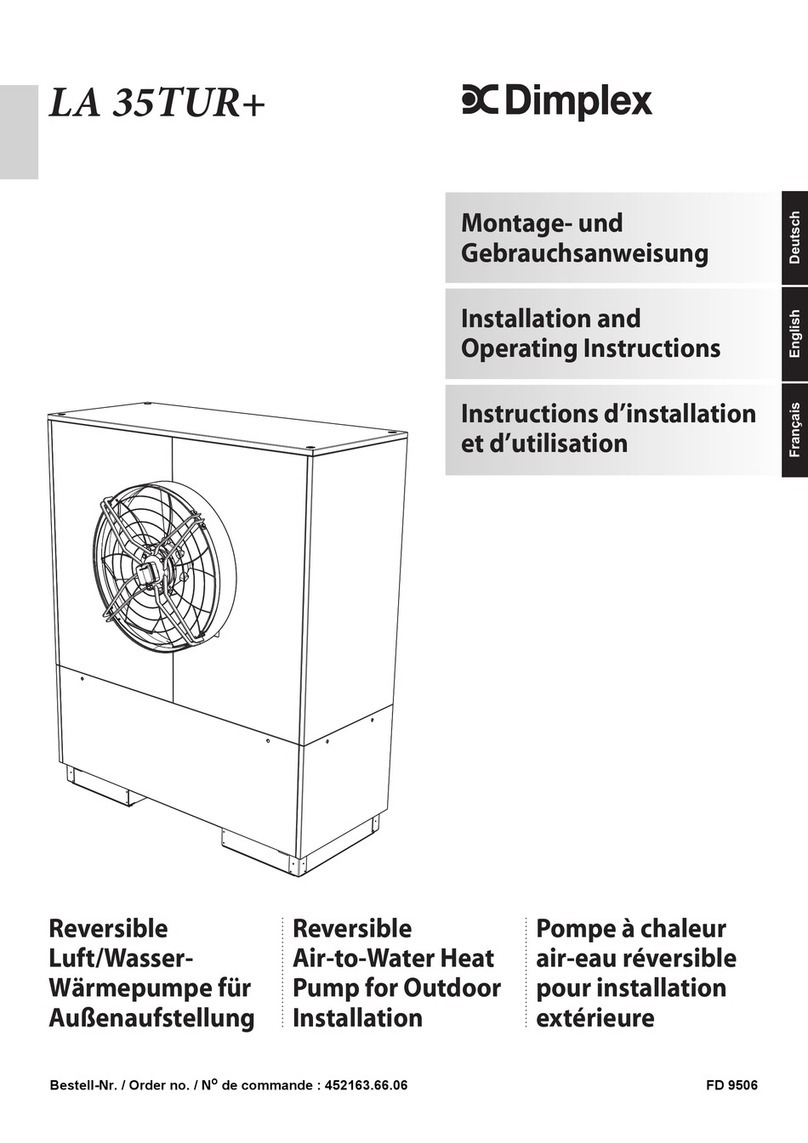
Dimplex
Dimplex LA 35TUR+ Installation and operating instructions

